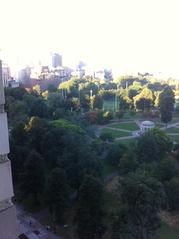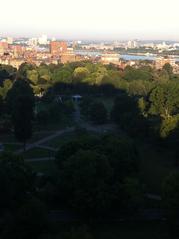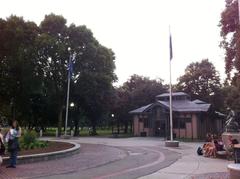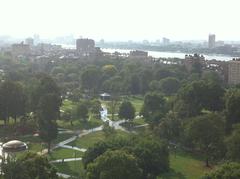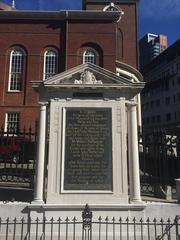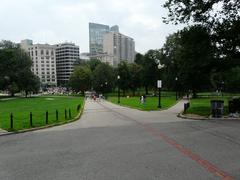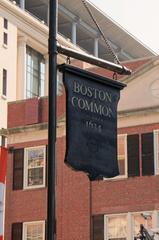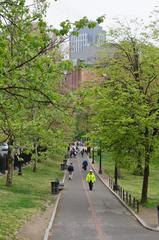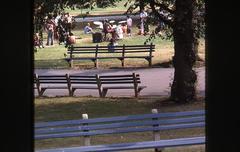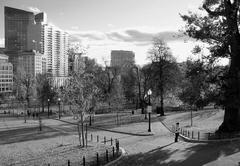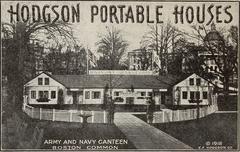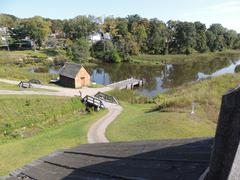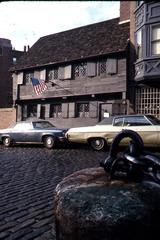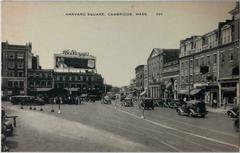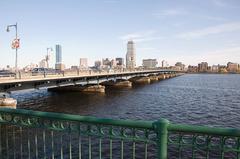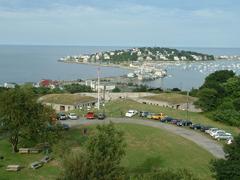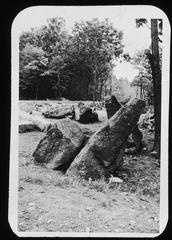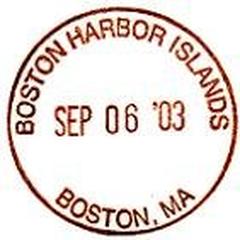
Visiting Hours, Tickets, and Historical Significance of Boston Common
Publication Date: 17/07/2024
Introduction to Boston Common
Boston Common, established in 1634, holds the distinguished honor of being the oldest public park in the United States. Situated at the heart of Boston, this historic site has witnessed pivotal moments in American history, from its early days as a communal grazing ground to its role in the American Revolution and beyond. The park’s transformation over the centuries—from a utilitarian space to a recreational haven—reflects the evolving needs and values of Boston’s residents. Today, Boston Common is not only a green oasis in an urban landscape but also a cultural and historical touchstone, attracting millions of visitors annually. With its rich tapestry of historical events, cultural significance, and recreational offerings, Boston Common serves as a vibrant testament to Boston’s enduring legacy. Whether you’re a history enthusiast, a nature lover, or simply looking to explore one of America’s most iconic public spaces, Boston Common offers a unique and enriching experience (Boston.gov, National Park Service, Friends of the Public Garden).
Table of Contents
- Introduction
- Early Beginnings
- Colonial Era
- Revolutionary War and Beyond
- 19th Century Developments
- 20th Century to Present
- Notable Monuments and Memorials
- Visitor Information
- Preservation and Modern Use
- Cultural Impact
- Visitor Experience
- FAQ
- Conclusion
Exploring the History and Visitor Guide of Boston Common - America’s Oldest Public Park
Early Beginnings
Boston Common, established in 1634, is the oldest public park in the United States. The land was originally purchased by the Puritan founders of the Massachusetts Bay Colony from William Blackstone, the first European settler of Boston. The Common was initially used as a communal grazing ground for cattle, a practice that continued until 1830. This early use underscores the Common’s role as a shared resource for the burgeoning community (Boston.gov).
Colonial Era
During the colonial period, Boston Common served multiple purposes beyond grazing. It was a site for public executions, a practice that continued until 1817. The most infamous execution was that of Mary Dyer, a Quaker who was hanged in 1660 for defying Puritan laws. The Common also hosted public gatherings, military training, and celebrations. In 1768, British troops camped on the Common during the occupation of Boston, a prelude to the American Revolution (Massachusetts Historical Society).
Revolutionary War and Beyond
Boston Common played a significant role during the American Revolutionary War. It was a staging ground for British troops before the Battle of Lexington and Concord in 1775. The Common also witnessed the departure of British forces in 1776 after the Siege of Boston. Post-revolution, the Common continued to be a central gathering place for public events and celebrations, including the annual Fourth of July festivities (National Park Service).
19th Century Developments
The 19th century saw significant changes to Boston Common. In 1830, the grazing of cattle was banned, marking a shift towards a more recreational use of the space. The Common was landscaped with pathways, trees, and ornamental gardens. The Frog Pond, a popular skating and swimming spot, was constructed in 1848. The Soldiers and Sailors Monument, dedicated in 1877, commemorates those who fought in the Civil War. These developments transformed the Common into a picturesque urban park (Boston Common Frog Pond).
20th Century to Present
The 20th century brought further enhancements and challenges to Boston Common. The park became a focal point for social and political movements, including civil rights rallies and anti-war protests. In 1965, Martin Luther King Jr. led a civil rights march to the Common, highlighting its role as a platform for social change. The park also faced issues of neglect and deterioration, leading to restoration efforts in the late 20th and early 21st centuries. Today, Boston Common is a vibrant urban oasis, hosting events, concerts, and recreational activities year-round (Friends of the Public Garden).
Notable Monuments and Memorials
Boston Common is home to several significant monuments and memorials that reflect its rich history. The Central Burying Ground, established in 1756, contains the graves of notable figures, including artist Gilbert Stuart. The Robert Gould Shaw and the 54th Regiment Memorial, dedicated in 1897, honors the first African American regiment to fight in the Civil War. The Parkman Bandstand, built in 1912, is a popular venue for concerts and public speeches. These landmarks offer visitors a glimpse into the historical and cultural significance of the Common (Boston Landmarks Commission).
Visitor Information
To make the most of your visit to Boston Common, here are some essential details:
- Visiting Hours: Boston Common is open daily from dawn to dusk.
- Tickets: Entrance to the park is free, but some events and attractions may require tickets.
- Travel Tips: The Common is easily accessible by public transportation, with nearby subway stops including Park Street (Red and Green lines) and Boylston (Green line).
- Nearby Attractions: Don’t miss nearby historical sites such as the Massachusetts State House, the Freedom Trail, and the Boston Public Garden.
- Accessibility: The park is wheelchair accessible, with paved pathways and ramps.
Preservation and Modern Use
Efforts to preserve and maintain Boston Common have been ongoing. The park is managed by the Boston Parks and Recreation Department, with support from organizations like the Friends of the Public Garden. Recent projects include the restoration of the Brewer Fountain and the renovation of the Frog Pond. The Common continues to evolve, balancing its historical legacy with the needs of a modern urban population. It remains a beloved green space, attracting millions of visitors each year (Boston Parks and Recreation Department).
Cultural Impact
Boston Common has left an indelible mark on American culture. It has been featured in literature, art, and film, symbolizing freedom, democracy, and community. The park’s role in historical events, from the American Revolution to the civil rights movement, underscores its importance as a site of public discourse and action. The Common’s enduring appeal lies in its ability to connect past and present, offering a space for reflection, recreation, and celebration (Boston Public Library).
Visitor Experience
Today, Boston Common offers a variety of attractions and activities for visitors. The park features walking paths, playgrounds, and sports facilities. Seasonal events, such as the Boston Common Tree Lighting and the Boston Freedom Rally, draw large crowds. The Visitor Information Center, located on Tremont Street, provides maps, guides, and historical information. Whether exploring its historical landmarks or enjoying a leisurely stroll, Boston Common offers a unique and enriching experience for all who visit (Boston USA).
FAQ
Q: What are the Boston Common visiting hours? A: Boston Common is open daily from dawn to dusk.
Q: Are there any ticket fees for Boston Common? A: Entrance to Boston Common is free, but certain events and attractions may require tickets.
Q: How can I get to Boston Common? A: The Common is easily accessible by public transportation, with nearby subway stops including Park Street (Red and Green lines) and Boylston (Green line).
Q: What are some nearby historical sites to Boston Common? A: Nearby attractions include the Massachusetts State House, the Freedom Trail, and the Boston Public Garden.
Conclusion
Boston Common stands as a testament to Boston’s rich heritage and its role in shaping American history. As you stroll through its pathways and explore its monuments, you are walking through centuries of stories and events that have defined this great nation. Be sure to visit Boston Common and experience firsthand the historical and cultural significance of America’s oldest public park. For more information and updates, download our mobile app Audiala, check out related posts, or follow us on social media.
Summary and Final Thoughts
Boston Common stands as a microcosm of Boston’s storied history and cultural evolution. As America’s oldest public park, it encapsulates the spirit of communal space, civic engagement, and historical reflection. From its early use as a grazing ground to its pivotal role in social and political movements, the park has continually adapted to meet the needs of its community. Today, Boston Common is a beloved urban sanctuary that offers a blend of historical landmarks, recreational activities, and cultural events. Its ongoing preservation efforts ensure that future generations can continue to enjoy and learn from this iconic space. Whether you’re exploring the scenic paths, attending a public event, or simply soaking in the historical ambiance, a visit to Boston Common promises a memorable and enriching experience. For more information and updates, be sure to check out related resources or follow on social media (Boston.gov, National Park Service, Friends of the Public Garden, Freedom Trail Foundation).
Sources and Further Reading
- Exploring the History and Visitor Guide of Boston Common - America’s Oldest Public Park, 2024, Boston.gov source
- Exploring Boston Common - History, Visiting Hours, Tickets, and More, 2024, Freedom Trail Foundation source
- Ultimate Guide to Visiting Boston Common - Hours, Tickets, and Attractions, 2024, Friends of the Public Garden source
